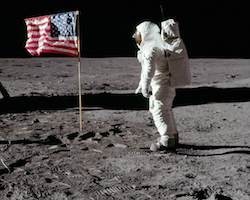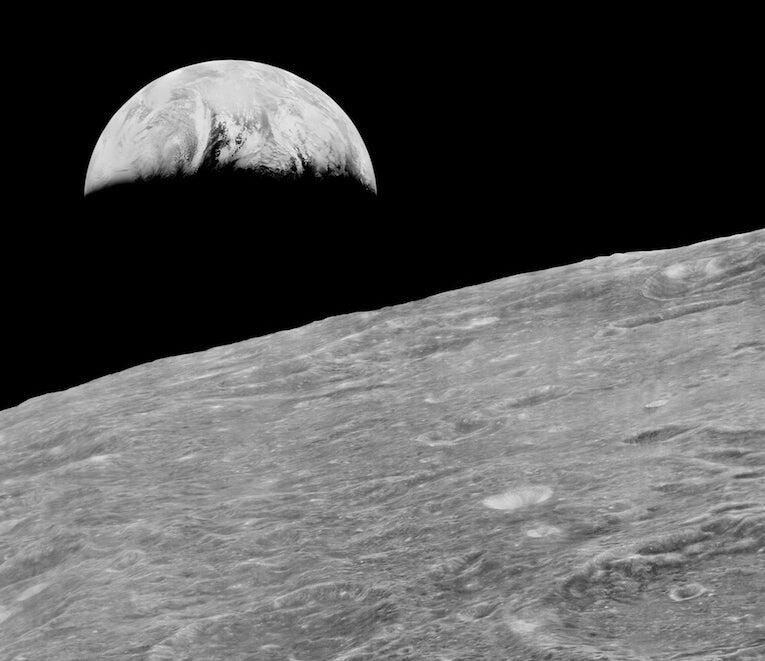Was the Moon Landing Live?
Submitted by: Mickey
Grade level: 10
Answered by: Patrick McGurrin
The Apollo 11 mission was an important event for the United States and the world. Astronauts Buzz Aldrin and Neil Armstrong climbed down the ladder of the lunar module and onto the surface of the moon. They took the first steps of any woman or man on this surface.
 Overall, there was a lot of excitement about landing on the moon. And while what was happening was discussed on the local news, it was fun for people to see for themselves. It was also helpful for NASA scientists to be able to see what was happening in addition to using radio communication.
Overall, there was a lot of excitement about landing on the moon. And while what was happening was discussed on the local news, it was fun for people to see for themselves. It was also helpful for NASA scientists to be able to see what was happening in addition to using radio communication.
To achieve this, the Apollo 11 mission included a camera on the mission so that both NASA and the world could see the crew as they prepared for the moon landing, and the landing itself. Three total transmissions were made between the ship and Earth to share the journey.
The most famous transmission, the moon landing itself, was broadcast to the world on July 21, 1969. This footage captured Armstrong and Aldrin climbing down from the lunar module and onto the surface of the moon. The camera was stored on the module itself so it did not need to be held. Once the two men had reached the moon’s surface, the camera was moved from the lunar module and placed on a tripod about 30 feet from it.
This footage was sent down to Earth and received by 3 places on the planet. These included Parkes Observatory and Honeysuckle Creek Tracking Station in Australia, and the Goldstone Tracking Station in California. These signals were then converted so that they could be seen by the world on the TVs in their homes. This conversion was necessary due to the type of equipment that the Apollo crew needed to use while in space.
These transmissions had a long way to travel to arrive to the TV in people’s homes. But this process only took a few seconds. And so while there was a short delay between the filming on the moon and viewing on Earth, the moon landing was watched live by NASA and the world.
The Moon “Hoax”?
A small percentage of people do not believe that NASA ever led a mission where astronauts landed on the moon. There are many arguments for why they believe the landing was fake and that the media coverage was created using props on Earth. To date, all of the arguments supporting this belief have been disproven.
Here we touch on three common arguments that support this false belief.
- The first claim is that the flag on the moon appears to be waving. Given that there is no wind on the moon, it is argued that the flag must then have been on Earth and not on the Moon. However, the way the flag was positioned was due to how it was set up. The flag had a vertical pole, which held it upright in a similar way to flagpoles that we see here on Earth. But this pole had a second portion that went horizontally (making a 90 degree angle at the top of the pole), which was meant to hold the flag out. This portion malfunctioned and did not come out all the way. Because the material of the flag was not pulled tight, it had creases in it that made it appear to be waving.
- A second claim is that pictures from the moon do not have any stars. With no air on the moon, the sky is black and so stars should have been visible. The air in the atmosphere is made up of lots of little particles, and light will bounce off of these particles. This can make it difficult to see the stars. We experience this on Earth, where stars are more difficult to see in cities that have a lot of this light pollution. With no air on the moon, we don’t have any light pollution, and so it should be easy to see the stars.
 The answer to this claim is that you can see stars on the surface of the moon. But you are unable to see them in the photos due to the settings on the camera. The sun generates a bright light on the surface of the moon, and so the camera had to be set to capture images in this very bright setting. The exposure time was set to be fast, and the aperture was set to be more closed, sort of like when you squint your eyes to see better outside on a sunny day. These settings on the camera actually cause the stars to not be recorded.
The answer to this claim is that you can see stars on the surface of the moon. But you are unable to see them in the photos due to the settings on the camera. The sun generates a bright light on the surface of the moon, and so the camera had to be set to capture images in this very bright setting. The exposure time was set to be fast, and the aperture was set to be more closed, sort of like when you squint your eyes to see better outside on a sunny day. These settings on the camera actually cause the stars to not be recorded.
If you happen to find a very dark spot on Earth, you could test this for yourself. If you use the same camera settings, you would find that when you took a picture of the landscape, the stars would be visible to the eye, but not present on the captured image.
- A third claim is that there are shadows in the captured images that are not simply black in color. If the only source of light on the moon was the sun, the shadows would be black. This is because there would be no light scattering into those areas of shadow to light them up. However, even though there is no air to scatter light, there are other sources of light on the moon. There may be a hint of light from the Earth. But the other (and main) source of light is the moon itself. Dust on the moon can actually reflect light. As the light from the sun reflected off the astronaut suits and the lunar module, it interacted with the dust on the moon to cause the shadows to appear a color other than pure black.
Image of Earth rise from the moon by NASA/Ames Research Center/Lunar Orbiter Image Recovery Project.

Do people really doubt that humans have visited the moon?
Be Part of
Ask An Earth and
Space Scientist
By volunteering, or simply sending us feedback on the site. Scientists, teachers, writers, illustrators, and translators are all important to the program. If you are interested in helping with the website we have a volunteers page to get the process started.
